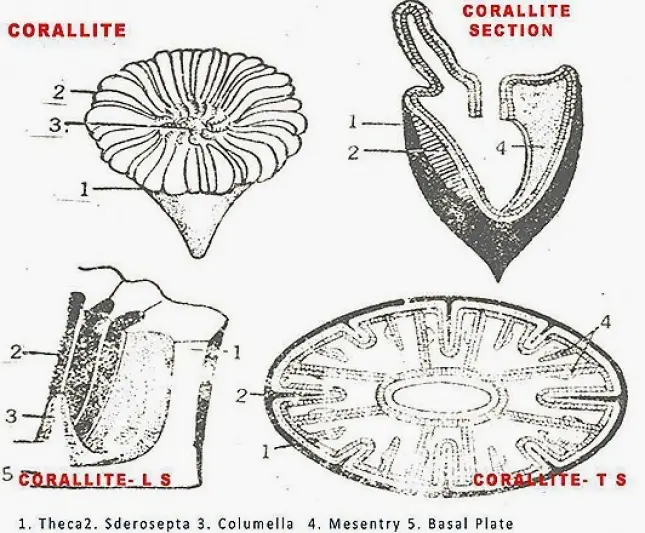Medically reviewed and approved by a board-certified member
Zoology
FORMATION OF CORALS AND TYPES
By BS MediaTwitter Profile | Updated: Wednesday, 17 January 2018 14:45 UTC

INTRODUCTION
- Corals are developed by the coelenterate organisms.
- Corals are a deposit of calcium carbonate.
- The coelenterate animal produces calcareous skeleton.
- But most coral producing polyps belong to the class Anthozoa.
- The true stony corals belong to the order Madreporaria of class Anthozoa. Many Solitary and colonial anthozoans produce corals which are sometimes brilliantly colored.
- The corals develop into coral rocks and coral islands.
CORAL PRODUCING POLYP STRUCTURE:
- A coral-polyp resembles sea-anemone in its shape.
- The coral is its external shell.
- It is a product of the ectodermal cells, called Calicoblasts.
- The formation of the coral is not clearly followed, so far Calcareous crystals may be precipitated in the matrix and secreted outside the epidermis.
- Thus outer protective shell may be formed.
- A coral polyp will not show a pedal disc as its basal part is surrounded by the calcareous skeleton.
- The oral disc bears tentacles in cycles of 6.
- The circular mouth leads into a short stomodeaum which will not show siphonoglyphs.
- The mesenteries are restricted to the upper part of the polyp.
- The muscles are poorly developed.
FORMATION OF CORALS
- The basal region of the coral polyp is fixed in a cup-shaped calcareous exoskeleton secreted by the epidermis of the base.
- On this basal plate a large number of radially arranged vertical septa are formed.
- They grow in height and they push the ectoderm up.
- An external wall is formed because of the circular up growth of the plate.
- The single cup like exoskeleton formed by an individual polyp is called a coralitte.
- It has the shape of the polyp.
- The majority of the corals are colonial, and the skeleton of an entire colony is termed coralium it may contain thousands of corallites.
Example for Coral formation
- In "Flabellum" the coral formation is based on these lines.
- The corallite is disc like. It is 5 mm to 25 cm. in length.
- The outer wall of the cup is made by stony calcium carbonate. It is called theca.
- The flattened bottom of the cup beneath the polyp is called the basal plate. The cavity of the cup develops a number of vertical septa or sclero-septa, proceeding form theca towards the center of the cup.
- Like mesenteries, they are typically arranged in cycles of six (6 primaries extending towards the center, 6 secondary’s, 12 tertiaries, 24 quartemaries etc.)
- The sclerosepta alternates with mesenteries Corallite lies entirely outside the polyp body.
- The polyp body is pushed up into ridges over the sclerosepta.
- Each ridge is covered by an internal portion of the body-wall Thus, the sclerosepta are external and lie outside the enteric cavity.
- Between the sclerosepta and the mesenteries, the polyp base is depressed into pockets called loculi.
- The inner ends of the primary sclerosepta are fused to form central column called columella.
- In many corals, the theca is covered by a second calcareous wall called epitheca. The space separating the epitheca and theca, will show projections called costae.
Types of Corals and Examples: The true corals belong to Anthozoa but in class hydrozoa also some corals are seen.
I. Hydrozoan Corals:
I. Hydrozoan Corals:
1. Millepora:
- It is a massive, calcareous skeleton with two types opening a) Large gastropores, b) Smaller dactylopores.
- Millipora is called stinging coral because it is the only coral with nematocysts, which causes pain to man.
2. Stylasterina:
- It is found in warm tropical water.
- The colony is tree like. It is also similar to millepora but has cup like gastropores. There is a pointed style in the centre of each cup.
II. Authozoan Corals:
1. Alcyonium (dead man's fingers):
- It is a marine colonial form living attached to stones.
- It is tree like. It grows to 4 to 10 cm height.
- The simplest form of skeleton is seen in this animal, which contains minute calcareous spicules.
2. Tubipora (organ-pipe coral):
- It is a marine colony distributed in warm waters The spicules are fused to form a tube around the polyp.
- Many such tubes are united by horizontal platforms Again new polyps are formed They develop vertical tubes.
- This process is repeated. A big coral is formed.
3. Corallium (red coral):
- It is a marine sedentary form.
- It grows to 30 cm. It is highly branched.
- The polyps are white in colour. Autozooids'and siphonozooids are present.
- Herd and branched skeletal axis is formed by the union of many calcareous spicules in a matrix.
- Thus a coral is developed which is red in colour.
4. Gorgonia (Sea fan):
- It is also called sea-whip.
- It is seen in tropical waters.
- It is tree like colony, it grows 80 cm. height.
- A central, rod like branched skeleton is formed by the ectoderm.
- Mesogloea also contains many calcareous spicules.
III. The corals belong to Madreporaria are true corals.
The skeleton is entirely calcareous and is secreted by the ectoderm. The following are good examples.
1. Fungia (Mushroom coral):
- It is marine form. The coral is discoid.
- The septa are numerous and are connected by small calcareous rods called synapticula.
- This coral is true coral.
2. Meandrina (Or Brain coral):
- It is very big and grows up to 8 feet in diameter.
- It weighs in tons.
- The surface of the colony is marked by long curved grooves; hence it looks like human brain.
- In a living brain coral the polyps do not occupy separate cups.
- The mouths of these compound polyps will be separate.
Tags:
End of the article